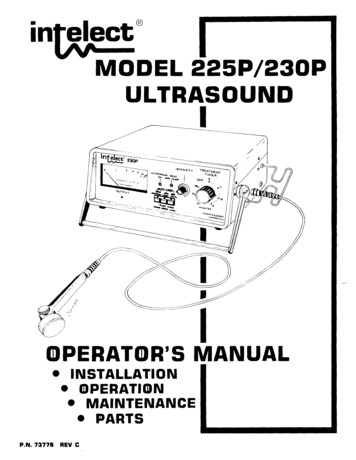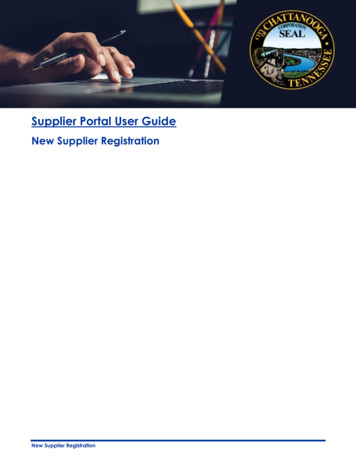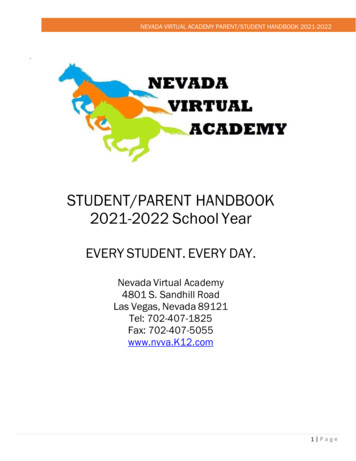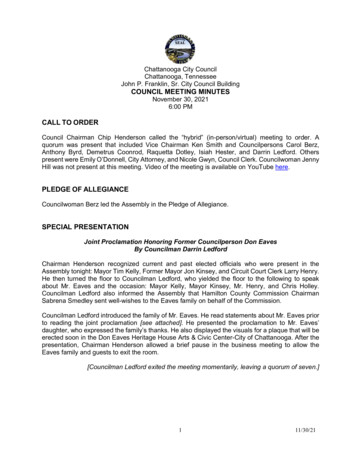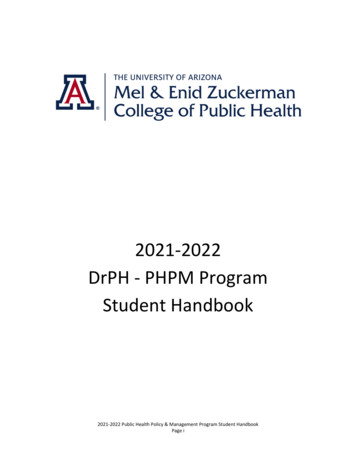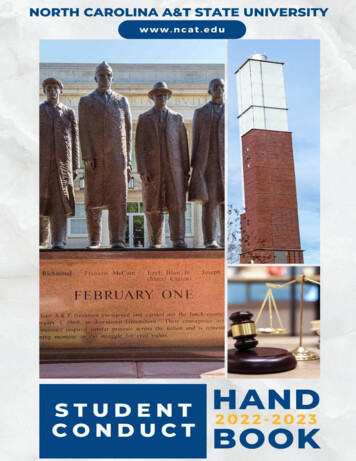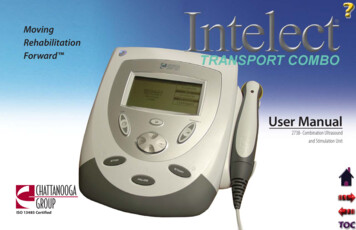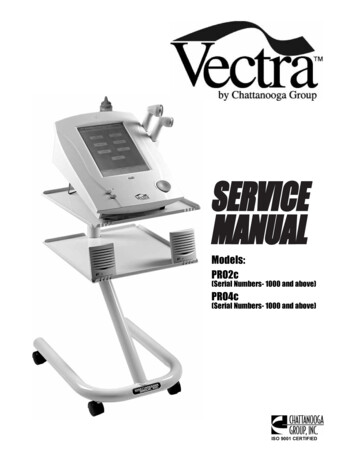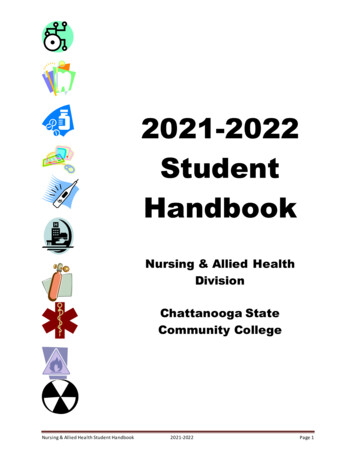
Transcription
2021-2022StudentHandbookNursing & Allied HealthDivisionChattanooga StateCommunity CollegeNursing & Allied Health Student Handbook2021-2022Page 1
Table of ContentsWelcome and Introduction . . . . . . . . . . . . . . . . . . . . . . . . . . . . . . . . . . . . . . . . . . . . . . . . . . . . . . . . . . . . . . . . . . . . . . . . . . . 4Chattanooga State Expectation - Academic Affairs Academic Misconduct Statement . . . . . . . . . . . . . . . . . . 5-6Division of Nursing & Allied Health - Academic Integrity Statement . . . . . . . . . . . . . . . . . . . . . . . . . . . . . . . . . . . . . 7-8Conduct in the Academic EnvironmentChannels of Communication . . . . . . . . . . . . . . . . . . . . . . . . . . . . . . . . . . . . . . . . . . . . . . . . . . . . . . . . . . . . . . . . . . . . . . . . . . . . 9Ethical and Moral Behavioral Expectations of Health Program Students . . . . . . . . . . . . . . . . . . . . . . . . . . . . . . . . . . . . . . . . 9Disruptive Conduct Policy . . . . . . . . . . . . . . . . . . . . . . . . . . . . . . . . . . . . . . . . . . . . . . . . . . . . . . . . . . . . . . . . . . . . . . . . . . . . . . 9Misuse of Computers Policy. . . . . . . . . . . . . . . . . . . . . . . . . . . . . . . . . . . . . . . . . . . . . . . . . . . . . . . . . . . . . . . . . . . . . . . . . . . . 9-10Academic RequirementsAttendance/Absence Policy . . . . . . . . . . . . . . . . . . . . . . . . . . . . . . . . . . . . . . . . . . . . . . . . . . . . . . . . . . . . . . . . . . . . . . . . . . . .Retention/Progression Criteria . . . . . . . . . . . . . . . . . . . . . . . . . . . . . . . . . . . . . . . . . . . . . . . . . . . . . . . . . . . . . . . . . . . . . . . . . .Readmission . . . . . . . . . . . . . . . . . . . . . . . . . . . . . . . . . . . . . . . . . . . . . . . . . . . . . . . . . . . . . . . . . . . . . . . . . . . . . . . . . . . . . . . . .Communication RequirementRequirements for Clinical Practice11111112Health Status . . . . . . . . . . . . . . . . . . . . . . . . . . . . . . . . . . . . . . . . . . . . . . . . . . . . . . . . . . . . . . . . . . . . . . . . . . . . . . . . . . . . . . . 13Seasonal Influenza . . . . . . . . . . . . . . . . . . . . . . . . . . . . . . . . . . . . . . . . . . . . . . . . . . . . . . . . . . . . . . . . . . . . . . . . . . . . . . . . . . . 13N95 Fit Testing . . . . . . . . . . . . . . . . . . . . . . . . . . . . . . . . . . . . . . . . . . . . . . . . . . . . . . . . . . . . . . . . . . . . . . . . . . . . . . . . . . . . . 13-14Criminal Background Check . . . . . . . . . . . . . . . . . . . . . . . . . . . . . . . . . . . . . . . . . . . . . . . . . . . . . . . . . . . . . . . . . . . . . . . . . . . 14Drug Free Policy . . . . . . . . . . . . . . . . . . . . . . . . . . . . . . . . . . . . . . . . . . . . . . . . . . . . . . . . . . . . . . . . . . . . . . . . . . . . . . . . . . . . . 15Notice to Students . . . . . . . . . . . . . . . . . . . . . . . . . . . . . . . . . . . . . . . . . . . . . . . . . . . . . . . . . . . . . . . . . . . . . . . . . . . . . . . . . . . 15Impaired Functioning . . . . . . . . . . . . . . . . . . . . . . . . . . . . . . . . . . . . . . . . . . . . . . . . . . . . . . . . . . . . . . . . . . . . . . . . . . . . . . . . . 16CPR Certification . . . . . . . . . . . . . . . . . . . . . . . . . . . . . . . . . . . . . . . . . . . . . . . . . . . . . . . . . . . . . . . . . . . . . . . . . . . . . . . . . . . . . 16Liability Insurance . . . . . . . . . . . . . . . . . . . . . . . . . . . . . . . . . . . . . . . . . . . . . . . . . . . . . . . . . . . . . . . . . . . . . . . . . . . . . . . . . . . . . 16Joint Commission Hospital Orientation Requirements . . . . . . . . . . . . . . . . . . . . . . . . . . . . . . . . . . . . . . . . . . . . . . . . . . . . . . . 16Clinical ExpectationsConfidentiality of Protected Health Information (HIPAA) . . . . . . . . . . . . . . . . . . . . . . . . . . . . . . . . . . . . . . . . . . . . . . . . . . 17-18Professionalism in the Program . . . . . . . . . . . . . . . . . . . . . . . . . . . . . . . . . . . . . . . . . . . . . . . . . . . . . . . . . . . . . . . . . . . . . . . . 18Blood and Body Substances Precautions . . . . . . . . . . . . . . . . . . . . . . . . . . . . . . . . . . . . . . . . . . . . . . . . . . . . . . . . . . . . . . . . . . 18HIV/AIDS/Hepatitis B . . . . . . . . . . . . . . . . . . . . . . . . . . . . . . . . . . . . . . . . . . . . . . . . . . . . . . . . . . . . . . . . . . . . . . . . . . . . . . . . . . 19COVID-19 . . . . . . . . . . . . . . . . . . . . . . . . . . . . . . . . . . . . . . . . . . . . . . . . . . . . . . . . . . . . . . . . . . . . . . . . . . . . . . . . . . . . . . . . . . . . .20Safety and Well Being in the Clinical Setting . . . . . . . . . . . . . . . . . . . . . . . . . . . . . . . . . . . . . . . . . . . . . . . . . . . . . . . . . . . . . 19-20Dress Code and Personal Hygiene . . . . . . . . . . . . . . . . . . . . . . . . . . . . . . . . . . . . . . . . . . . . . . . . . . . . . . . . . . . . . . . . . . . . . . . 20Conflict of Conscience . . . . . . . . . . . . . . . . . . . . . . . . . . . . . . . . . . . . . . . . . . . . . . . . . . . . . . . . . . . . . . . . . . . . . . . . . . . . . . . . . 20Tips and Gifts . . . . . . . . . . . . . . . . . . . . . . . . . . . . . . . . . . . . . . . . . . . . . . . . . . . . . . . . . . . . . . . . . . . . . . . . . . . . . . . . . . . . . . . . 20General InformationCell Phones and Other Personal Communication Devices . . . . . . . . . . . . . . . . . . . . . . . . . . . . . . . . . . . . . . . . . . . . . . . . . . . . 21Email Communication . . . . . . . . . . . . . . . . . . . . . . . . . . . . . . . . . . . . . . . . . . . . . . . . . . . . . . . . . . . . . . . . . . . . . . . . . . . . . . . . . 21Emergency Alert Notification System (Tiger Alerts) . . . . . . . . . . . . . . . . . . . . . . . . . . . . . . . . . . . . . . . . . . . . . . . . . . . . . . . . . 21Emergency Phone Call . . . . . . . . . . . . . . . . . . . . . . . . . . . . . . . . . . . . . . . . . . . . . . . . . . . . . . . . . . . . . . . . . . . . . . . . . . . . . . . . . 21Drug Free Policy. . . . . . . . . . . . . . . . . . . . . . . . . . . . . . . . . . . . . . . . . . . . . . . . . . . . . . . . . . . . . . . . . . . . . . . . . . . . . . . . . . . . . . 21Code of Ethics . . . . . . . . . . . . . . . . . . . . . . . . . . . . . . . . . . . . . . . . . . . . . . . . . . . . . . . . . . . . . . . . . . . . . . . . . . . . . . . . . . . . . . . . 22General Conduct . . . . . . . . . . . . . . . . . . . . . . . . . . . . . . . . . . . . . . . . . . . . . . . . . . . . . . . . . . . . . . . . . . . . . . . . . . . . . . . . . . . . . 22Inclement Weather . . . . . . . . . . . . . . . . . . . . . . . . . . . . . . . . . . . . . . . . . . . . . . . . . . . . . . . . . . . . . . . . . . . . . . . . . . . . . . . . . . 22-23Personal Life in the Academic and Clinical Setting . . . . . . . . . . . . . . . . . . . . . . . . . . . . . . . . . . . . . . . . . . . . . . . . . . . . . . . . . . 23Smoking Policy . . . . . . . . . . . . . . . . . . . . . . . . . . . . . . . . . . . . . . . . . . . . . . . . . . . . . . . . . . . . . . . . . . . . . . . . . . . . . . . . . . . . . 23Strangers and Difficult Persons . . . . . . . . . . . . . . . . . . . . . . . . . . . . . . . . . . . . . . . . . . . . . . . . . . . . . . . . . . . . . . . . . . . . . . . . . . 23Theft . . . . . . . . . . . . . . . . . . . . . . . . . . . . . . . . . . . . . . . . . . . . . . . . . . . . . . . . . . . . . . . . . . . . . . . . . . . . . . . . . . . . . . . . . . . . . . . . 23Weapons . . . . . . . . . . . . . . . . . . . . . . . . . . . . . . . . . . . . . . . . . . . . . . . . . . . . . . . . . . . . . . . . . . . . . . . . . . . . . . . . . . . . . . . . . . . . 24Title IX: Sexual Misconduct Policy and Reporting . . . . . . . . . . . . . . . . . . . . . . . . . . . . . . . . . . . . . . . . . . . . . . . . . . . . . . . . . 24-25Bullying . . . . . . . . . . . . . . . . . . . . . . . . . . . . . . . . . . . . . . . . . . . . . . . . . . . . . . . . . . . . . . . . . . . . . . . . . . . . . . . . . . . . . . . . . . . . . 25Social Media . . . . . . . . . . . . . . . . . . . . . . . . . . . . . . . . . . . . . . . . . . . . . . . . . . . . . . . . . . . . . . . . . . . . . . . . . . . . . . . . . . . . . . . . . 25Policy Violations . . . . . . . . . . . . . . . . . . . . . . . . . . . . . . . . . . . . . . . . . . . . . . . . . . . . . . . . . . . . . . . . . . . . . . . . . . . . . . . . . . . . . . . 25Reference and Contact Information . . . . . . . . . . . . . . . . . . . . . . . . . . . . . . . . . . . . . . . . . . . . . . . . . . . . . . . . . . . . . . . . . . . . 25-26Notice of Services for Students with Disabilities . . . . . . . . . . . . . . . . . . . . . . . . . . . . . . . . . . . . . . . . . . . . . . . . . . 26Statement of Nondiscrimination . . . . . . . . . . . . . . . . . . . . . . . . . . . . . . . . . . . . . . . . . . . . . . . . . . . . . . . . . . . . . . . . . . . . . . 26Health Science Center, CBIH, OmniplexParking . . . . . . . . . . . . . . . . . . . . . . . . . . . . . . . . . . . . . . . . . . . . . . . . . . . . . . . . . . . . . . . . . . . . . . . . . . . . . . . . . . . . . . . . . . . . . . 27Resource Room (Computer Lab) . . . . . . . . . . . . . . . . . . . . . . . . . . . . . . . . . . . . . . . . . . . . . . . . . . . . . . . . . . . . . . . . . . . . . . . . . 27Student Lounges . . . . . . . . . . . . . . . . . . . . . . . . . . . . . . . . . . . . . . . . . . . . . . . . . . . . . . . . . . . . . . . . . . . . . . . . . . . . . . . . . . . . . . 27Classrooms. . . . . . . . . . . . . . . . . . . . . . . . . . . . . . . . . . . . . . . . . . . . . . . . . . . . . . . . . . . . . . . . . . . . . . . . . . . . . . . . . . . . . . . . . . 27Emergencies . . . . . . . . . . . . . . . . . . . . . . . . . . . . . . . . . . . . . . . . . . . . . . . . . . . . . . . . . . . . . . . . . . . . . . . . . . . . . . . . . . . . . . . 27-28Nursing & Allied Health Student Handbook2021-2022Page 2
Campus Police . . . . . . . . . . . . . . . . . . . . . . . . . . . . . . . . . . . . . . . . . . . . . . . . . . . . . . . . . . . . . . . . . . . . . . . . . . . . . . . . . . . . . . . 28Signature PagesSignature Form: Handbook Acknowledgement . . . . . . . . . . . . . . . . . . . . . . . . . . . . . . . . . . . . . . . . . . . . . . . . . . . . . . . . . . . . . . . 30Signature Form: Drug/Alcohol Policy Acknowledgement . . . . . . . . . . . . . . . . . . . . . . . . . . . . . . . . . . . . . . . . . . . . . . . . . . . . . . . 31Signature Form: Health Information, Confidentiality and Security Agreement . . . . . . . . . . . . . . . . . . . . . . . . . . . . . . . . . . . . . . 32Signature Form: Authorization for Release of Clinical Student Information and Acknowledgement . . . . . . . . . . . . . . . . . . . . 33Signature Form: Student Personal Information Release Authorization Form . . . . . . . . . . . . . . . . . . . . . . . . . . . . . . . . . . . . . . . 34Signature Form: Student Clinical Personal Information Release Authorization Form . . . . . . . . . . . . . . . . . . . . . . . . . . . . . . . .35Signature Form: Student Acknowledgment & Understanding Background Check/Drug/Alcohol Screening . . . . . . . . . . . . . . . . . 36Nursing & Allied Health Student Handbook2021-2022Page 3
Letter of Welcome – from the DeanDear Students,Welcome to the Division of Nursing & Allied Health, and congratulations on being accepted into your program ofstudy. We are very proud of our division, our programs, and the opportunities we provide to enable students topursue their career in nursing and the allied health professions. The sincere desire of the faculty and staff of thisdivision is to provide you with the knowledge and skills that you need to enter into your chosen career. I urge youto carefully read the material in this handbook, as it contains information that is important to your success.Dr. Mark A. KnutsenDean of Nursing & Allied Health DivisionHSC-2088IntroductionCongratulations on beginning a new phase of your life as you enter the Nursing or an Allied Health program atChattanooga State. The faculty and staff wish you success.The Nursing & Allied Health career programs at Chattanooga State strive to provide students with the besteducation and preparation for entry into a health career that is available. Each program is designed to preparehealthcare professionals that are desired by employers based on academics, professionalism, and work ethic tomeet the expectations of today’s workplace.Information, policies, and procedures common to all students in the Division of Nursing & Allied Health atChattanooga State are contained in this handbook. The policies contained in this handbook are designed tocomplement the Chattanooga State Student Handbook. The Chattanooga State Student Handbook is available atall times on the Chattanooga State website.Additional information, policies, and procedures unique to each program will be provided during that program’sorientation.Any questions regarding information in this handbook will be answered by faculty in your respective program.Students are expected to not only understand, but to comply with the policies, procedures, and guidelinescontained in all handbooks, including the Chattanooga State Community College Handbook, which is availableonline at www.chattanoogastate.edu, as well as any other program materials. A copy of the signedacknowledgement form found in the back of the handbook must be on file with the student’s selected program.General Note to Students:Faculty reserve the right to modify this handbook. Students will be informed verbally and/or in writing of anychanges that may occur.Nursing & Allied Health Student Handbook2021-2022Page 4
Chattanooga State ExpectationAcademic Affairs MisconductChattanooga State is committed to maintaining an environment of learning where high academic standards, aswell as academic and personal integrity are valued. Academic Misconduct, Violations of Academic Integrity, and/or“cheating” include but are not limited to the following:a) The use of sources beyond those authorized by the instructor in writing papers, preparing reports, solvingproblems, carrying out assignments, completing projects and taking tests.b) Unauthorized access to former tests, test banks, instructors’ materials or other academic materialc) The misrepresentation of papers, reports, assignments or other materials as the product of a student's soleindependent effort, for the purpose of affecting the student's grade, credit, or status in the College.d) The use of unauthorized technical devices, cell phones, calculators, etc.e) Failing to adhere to the instructions of the proctor or instructor in test-taking procedures; examples include,but are not limited to, talking, laughing, failure to take a seat assignment, failing to adhere to starting andstopping times, using or having unauthorized sources or devices or other disruptive activity.f) Influencing, or attempting to influence, any College official, faculty member, or employee possessing academicgrading and/or evaluation authority or the responsibility for maintenance of academic records, etc. throughthe use of bribery, threats, or any other means or coercion in order to affect a student's grade or evaluation.This also applies to clinical site supervisors;g) Any forgery, alteration, unauthorized possession, or misuse of College documents pertaining to academicrecords.h) Submitting the work of another student as the student’s own.i) Falsification of data.j) Unauthorized collaboration on exams or class assignment.k) "Plagiarism" includes, but is not limited to, the use, by paraphrase or direct quotation, of the published orunpublished work of another person without full or clear acknowledgment. It also includes theunacknowledged use of materials prepared by another person or agency engaged in the selling of term papersor other academic materials. Plagiarism also includes the use of key ideas of another person without propercitation.l) The term "academic misconduct" includes, but is not limited to, all acts of cheating and plagiarism as definedabove.FACULTY PROCEDURES AND PROTOCOLThe faculty member who determines that a student has engaged in an act of academic misconduct, violatedprinciples of academic integrity and/or “cheated” in connection with an assignment, test, course taught by thefaculty member or an examination proctored by the faculty member, or his or her designee, may choose toexercise the disciplinary process as outlined below, if the student does not accept the faculty member’sdetermination and accept the penalty prescribed in the syllabus:1. The instructor will collect all information regarding the situation. Such information may include the student’spapers, printed copies of material from a book or website, tests, unauthorized sources or unauthorizeddevices.2. The faculty member will complete the “Academic Integrity Violation Report.” This form can be located inTigerWeb or on the Chattanooga State website.3. The faculty member will notify the appropriate department chairperson of the action.4. The faculty member will notify the student and schedule a conference with him or her. During the conferencethe faculty member will present the student with a copy of the “Academic Integrity Violation Report” form.Supporting documentation of the academic integrity violation will accompany the form. The form mustinclude possible sanctions for the violation.5. The faculty member will discuss the incident as described on the form including the possible sanctions.6. The faculty member will give the student a chance to respond and a written statement from the student willbe attached to the form.7. A student’s grade in the course, or the assignment or examination affected by the alleged academicmisconduct may be lowered to any extent, including a grade of “F.”8. The faculty member will explain the student’s right to due process. The student will also be given a copy of theNursing & Allied Health Student Handbook2021-2022Page 5
Academic Integrity Violation Incident Report, information describing due process rights and the hearingprocedures in written format.STUDENT PROCEDURES AND PROTOCOL1. If the student admits violation, the student indicates yes on the Academic Integrity violation report form. If thestudent admits the violation and agrees to the sanctions to be imposed by the faculty member, the violationreport form will be filed with the Academic Department head and a copy forwarded to the Academic IntegrityCommittee Chairperson, the Vice President for Academic Affairs Office, and the Judicial Affairs Office. Thereport will be kept on file in the office of the Vice President of Academic Affairs and with the Judicial AffairsOffice.2. If the student does not accept the faculty member’s findings and /or sanctions, he or she may elect a hearing.The student will be referred to the appropriate department to request a hearing.3. To elect a hearing, the student will contact the department head. The student must make the request to thedepartment head within five (5) days of the conference with the instructor.ACADEMIC INTEGRITY COMMITTEE PROCEDURES AND PROTOCOLThe Academic Integrity Hearing Committee is a college-wide standing committee composed of the committeechair, two (2) faculty members, (1) staff member and two (2) students, all appointed by the Vice President ofAcademic Affairs or his or her designee. Academic Integrity Hearing Committee members will serve staggeredterms of three calendar years. If a committee member is not able to serve the three year term, the Vice Presidentof Academic Affairs will appoint a replacement. A majority of the Committee members present for a hearing mustbe in agreement in order for a decision to be binding on a student.1. A hearing will be scheduled as promptly as possible, but no sooner than five (5) days after the request forhearing is received.2. The student will be notified of the time, date, and place of the hearing, allowing reasonable time forpreparation.3. Failure of the student to appear at a hearing will be treated as a waiver of the right to a hearing.4. The chairman of the Academic Integrity Hearing Committee will conduct the hearing.5. The Academic Integrity charge and documenting information will be presented to the board by the facultymember or his or her designee.6. The student will have the right to present her or his case, to be accompanied by an advisor, to call witnessesand to confront witnesses, and to challenge the method and time limitations for appeal.7. The committee will render a decision at the conclusion of the hearing by a majority vote. A majority of themembers of the hearing committee must be in agreement in order for a decision to be binding.8. A copy of the decision will be sent to the student within three business days, and a copy will be forwarded tothe office of the Vice President of Academic Affairs, and the office of Judicial Affairs.9. The student may appeal the decision of the Academic Integrity Hearing Committee to the Vice President forAcademic Affairs within five (5) business days of notification of the decision. Such appeals must be in writingand shall be delivered to the Office of the Vice President for Academic Affairs.VICE PRESIDENT OF ACADEMIC AFFAIRS PROCEDURES AND PROTOCOL1. The Vice President will review the written appeal form from the student which must include the student’sbasis for the appeal, the record of the Academic Integrity Hearing Committee, the attached documentation,and other relevant information.2. The Vice President for Academic Affairs will issue a written decision within five (5) business days. The decisionof the Vice President for Academic Affairs will be final.Nursing & Allied Health Student Handbook2021-2022Page 6
Division of Nursing & Allied HealthAcademic Integrity StatementThe Division of Nursing & Allied Health is committed to the identification, affirmation, and promotion of the valuesof Academic Integrity.The Center for Academic Integrity (CAI) defines academic integrity as: “A commitment, even in the face ofadversity, to five fundamental values: honesty, trust, fairness, respect, and responsibility. From these values flowprinciples of behavior that enable academic communities to translate ideals into action.” (The above definition andthe following five value statements are quoted and/or adapted from The Fundamental Values of AcademicIntegrity, The Center for Academic Integrity, Duke University, October 1999.)HonestyHonesty begins with oneself and extends to others. In the quest for knowledge, students andfaculty alike must be honest with themselves and with each other, whether in the classroom,laboratory, library, clinical site, or in the community at large.TrustPeople respond to consistent honesty with trust. Trust is also promoted by faculty who set clearguidelines for assignments and for evaluating student work; by students who prepare work that ishonest and thoughtful; and by schools that set clear and consistent academic standards and thatsupport honest and impartial research.FairnessFair and accurate evaluation is essential in the educational process. For students, importantcomponents of fairness are predictability, clear expectations, and a consistent and just responseto dishonesty. Faculty also has a right to expect fair treatment, not only from students but alsofrom colleagues and their administration.RespectStudents show respect by attending class, being on time, paying attention, listening to otherpoints of view, being prepared for, and contributing to discussions, meeting academic deadlines,and performing to the best of their abilities. Being rude, demeaning, or disruptive is the antithesisof respectful conduct. Faculty show respect by taking students’ ideas seriously, providing full and honestfeedback on their work, valuing their aspirations and goals, and recognizing them asindividuals. All must show respect for the work of others by acknowledging their intellectual debtsthrough proper identification of sources.ResponsibilityBeing responsible means taking action against wrongdoing, despite peer pressure, fear, loyalty, orcompassion.At a minimum, individuals should take responsibility for their own honesty and should discourageand seek to prevent misconduct by others. This may be as simple as covering one’s own answersduring a test or as difficult as reporting a friend for cheating, as required by some honor codes.Whatever the circumstances, members of an academic community must not tolerate or ignoredishonesty on the part of others.Nursing & Allied Health Division Policy on Academic IntegrityThe academic work of all students must comply with all policies on academic honesty as detailed in statement andNursing & Allied Health Division policy statements. Violations of these policies are prohibited and include, but arenot limited to, an attempt by one or more students to use unauthorized information in the taking of an exam; or,to submit as one’s own work, themes, reports, drawings, laboratory notes, computer programs or other productsprepared by another person; or knowingly to assist another student in obtaining or using unauthorized materials.Nursing & Allied Health Student Handbook2021-2022Page 7
Students can make copies of journal articles for personal use; however, selling of such copies is an infringement ofthe Copyright Act.Plagiarism, cheating and other forms of academic dishonesty are prohibited. Students guilty of academicmisconduct, either directly or indirectly through participation or assistance, are immediately responsible to theinstructor of the class. The instructor has the authority to assign an “F” or a zero for the exercise or examination orto assign an “F” in the course. In addition to academic sanctions, disciplinary sanctions may also be imposedthrough the regular institutional procedures as a result of academic misconduct.Nursing & Allied Health Student Handbook2021-2022Page 8
Conduct in the Academic EnvironmentChannels of CommunicationAs in any organization, there are appropriate lines of authority and channels of communication. If a problem ariseswhile in a health career program, the channels of communication must be followed according to the sequence inthe chain of command: Course faculty Program Director Dean of Nursing & Allied Health Division Provost and Vice President for Academic Affairs President of the CollegeWhen this line of communication is not used and a higher positioned individual is contacted, the communicationmoves back down the chain until the person with the most direct knowledge of the issue is contacted.Ethical and Moral Behavioral Expectations of Health Program StudentsStudents accepted into a health career program are expected to demonstrate professional behavior and demeanor.Professional behavior is believed to encompass a broad range of expectations, including trustworthiness and keepingthe welfare of the individual receiving care as priority.Following implementation of the college judicial affairs process, any student found guilty of misrepresentation orthe intent to misrepresent facts will be dismissed from the program of study. Misrepresentation of facts eitherverbally or in writing can include, but is not necessarily be limited to: Bribery in any formFalsification or deliberate withholding of information about self that would negatively impact or endangerothers, including but not limited to communicable diseases, criminal activities, etc.Falsification or deliberate withholding of information about a patient or patient careActs of plagiarism or cheating in any formForgery or falsification of any document in any formTheft in any form (includes, but not exclusive to medical supplies, patient belongings, and ProtectedHealth Information [PHI])Inaccurate or incomplete information on program application formStudents are also responsible for the behavioral expectations set forth in the Chattanooga State StudentDisciplinary Policy as described on the college website. All students will be afforded due process as outlined in thePolicy Statement.Disruptive Student Policy (Rev. 2.3.12)The term “classroom disruption” means behavior which is abusive, obscene, lewd, indecent, violent, excessivelynoisy, disorderly, or which repeatedly interferes with the activities of a class. Students should refrain frominappropriate and/or offensive language, comments and actions (both on-ground and online).Online students arerequired to adhere to the same professional, legal and ethical standards of conduct as on-ground students,including the generally accepted standards of "etiquette" for all electronic communications online. Faculty areauthorized to take the following actions: direct persistently disruptive students to leave the class; dismiss the class,if appropriate; contact the Chattanooga State Police Department, if necessary. Faculty will also take these actions:tell the student(s) the reason for such actions; give them an opportunity to discuss the matter; consult with thedepartment chair and/or division dean, and the college judicial officer. Any student concerned about the conductof another student, should contact the teacher, department head, or division dean.Misuse of Computers and Other Personal Electronic DevicesUnauthorized or inappropriate use of computers or electronic devices is prohibited. Such use includes, but is notlimited to: damaging or altering records or programs furnishing false information invading the privacy of another by using files, programs or data without authorization engaging in disruptive, harassing and annoying behavior whether in person or onlineNursing & Allied Health Student Handbook2021-2022Page 9
viewing obscene, por
Nursing & Allied Health Student Handbook 2021-2022 Page 1 . 2021-2022 . Student . Handbook. . including the Chattanooga State Community College Handbook, which is available online at www.chattanoogastate.edu, as well as any other program mat erials. . The instructor will colel ct all information regarding the situation. Such information may .

